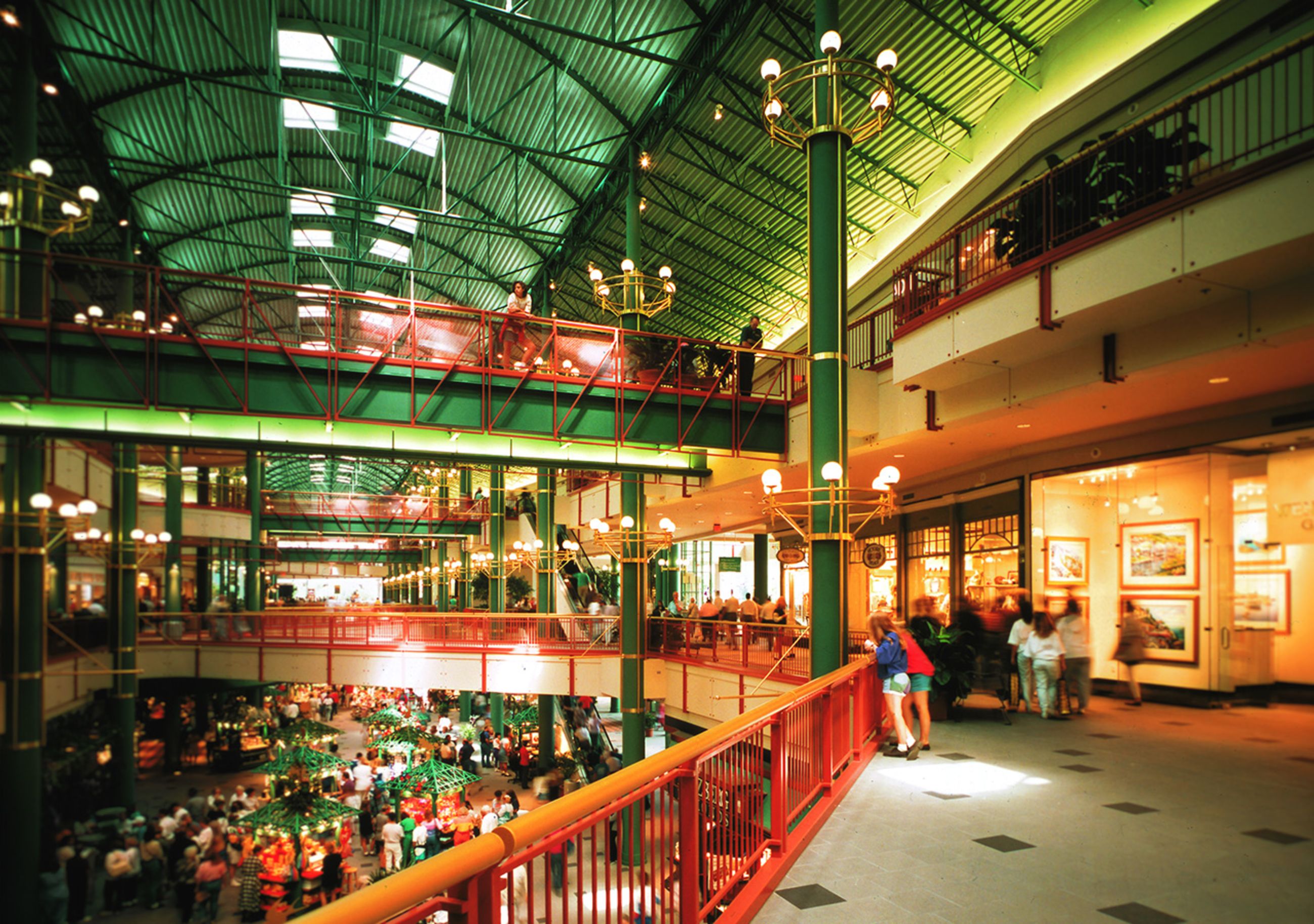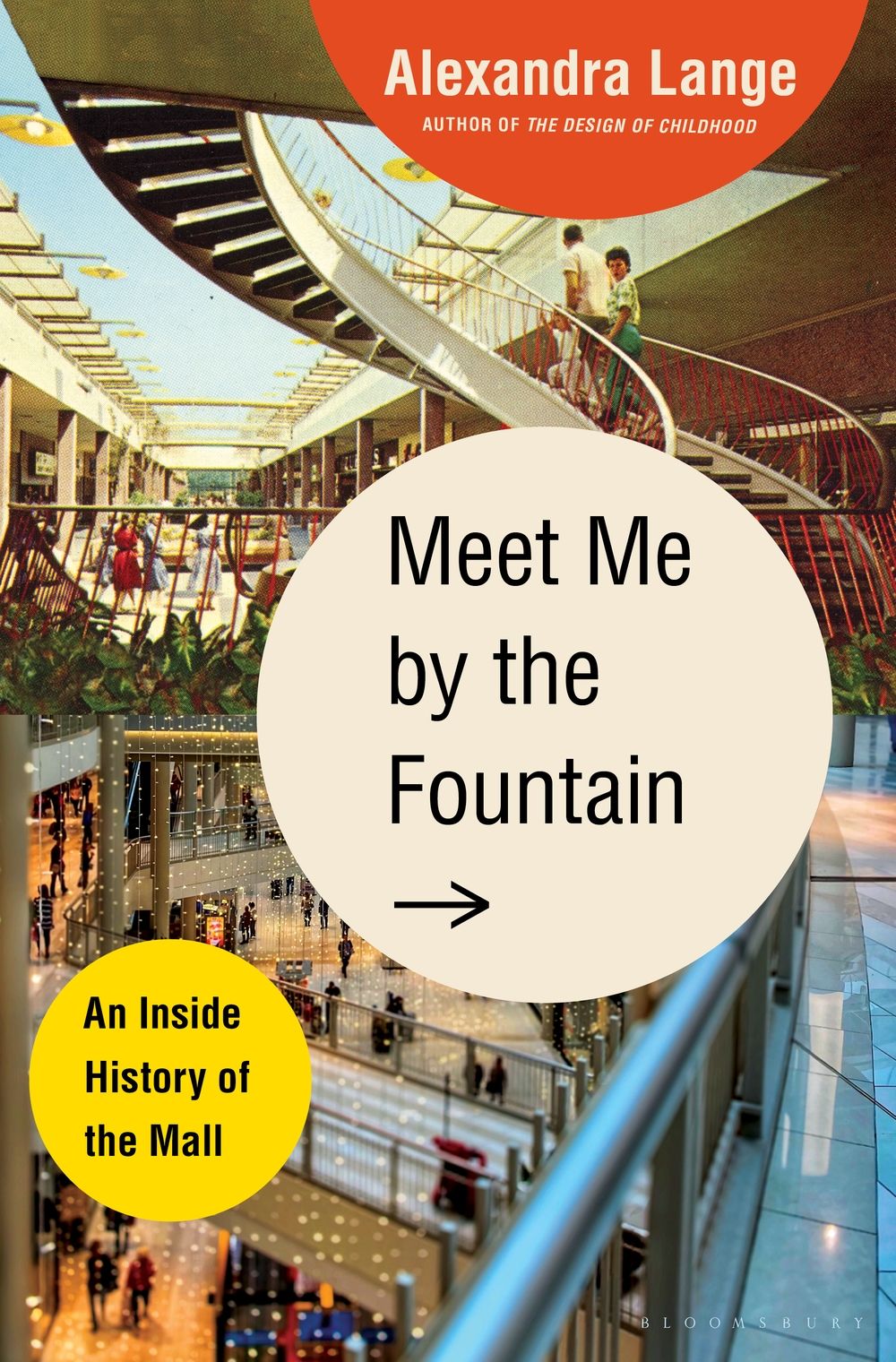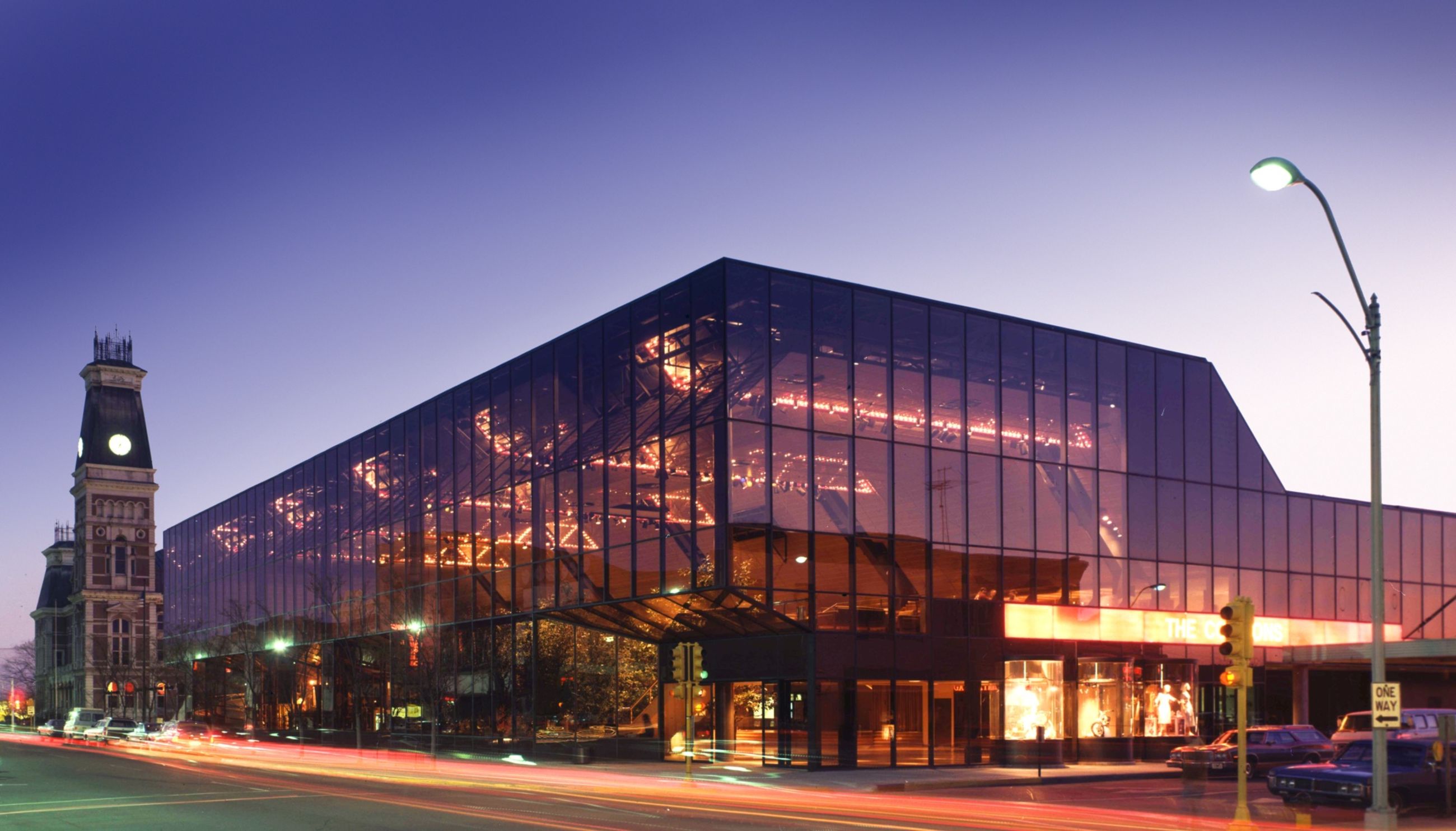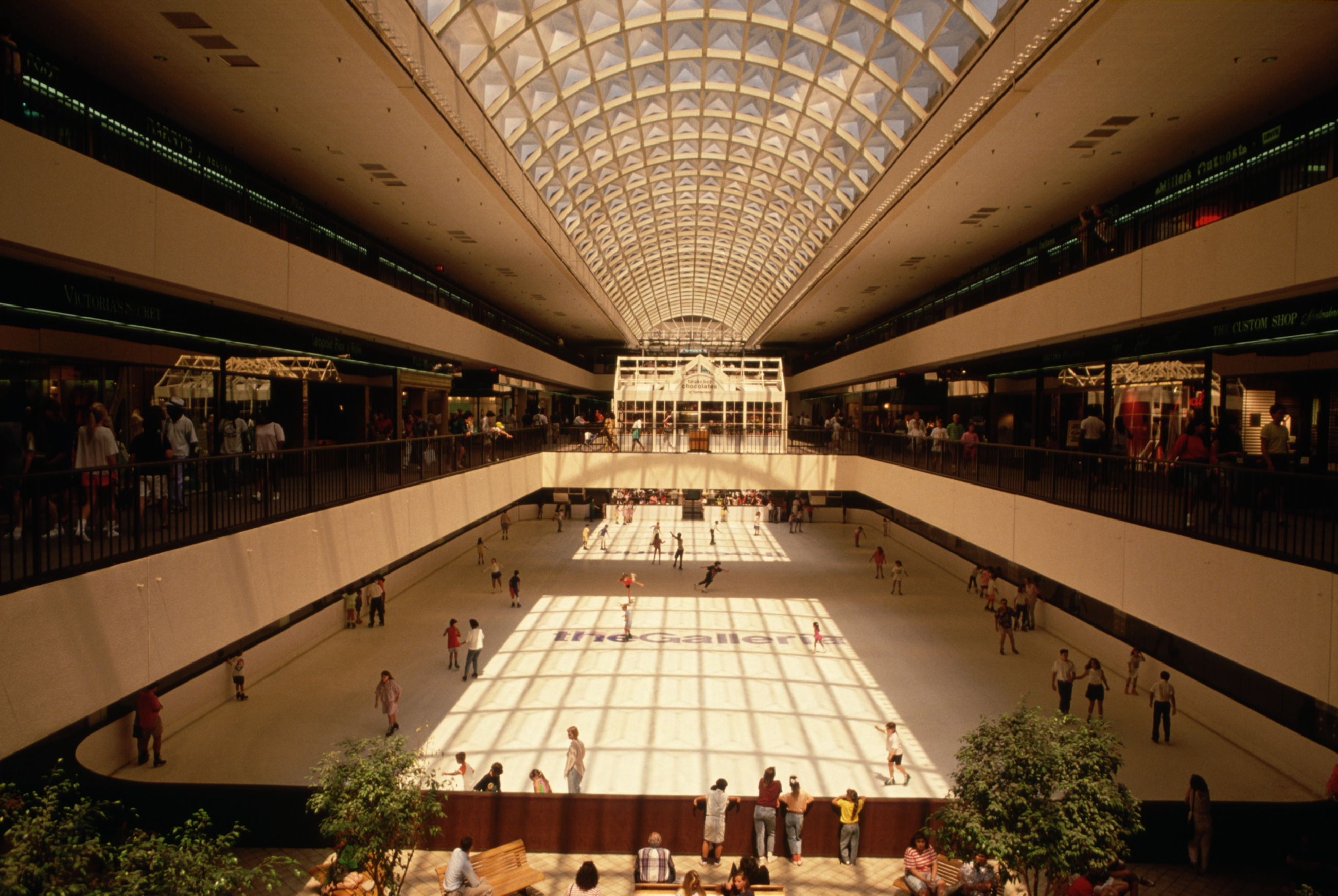
Malls such as the Winter Garden in New York, designed by Cesar Pelli & Associates with Diana Balmori, offer pedestrian amenities that many cities rarely provide. Photo by Photographer: Pelli Clarke & Partners
When Caroline Knutson began walking laps at the Lancaster Mall in Salem, Oregon, in 1982, she felt like she was onto something. She had signed up for TOPS — Take Off Pounds Sensibly, a nationwide nonprofit wellness group — and it provided new friends as well as a new routine. She chatted, shopped and exercised, on dark winter mornings as well as light summer ones. Back then she drove herself to the mall and walked without assistance. By 2013, when the The Statesman Journal caught up with her, she was vision impaired and using a rolling walker. Her daughter had to drop her off, but she still showed up most weekday mornings at the mall. Now she made one half-mile loop of the mall rather than six to eight.
“Asked how she navigates the mall with such poor vision, she chuckles through her response: ‘I’ve walked there since 1982. I know that mall,’” reads the Journal profile. After heart surgery in 2003, a doctor suggested she get on a treadmill. “I’m a mall walker!” Knutson’s daughter remembers her mother proclaiming.
Was Knutson the original “mall walker”? It is hard to say for certain, as mall walking is a sport without a federation. It’s an activity dominated by a population the media often ignores, and it primarily occurs before official store-opening hours. For teens and older or disabled adults, the mall appears as a ready-made ersatz city, a theme park of urbanity even without the simulated New Orleans latticework of destination shopping experiences like the Mall of America. The mall was always intended as a protected space, its stores and spaces targeting suburban women and children at home during the day and isolated from walkable downtowns.

The Mall of America, perhaps the most iconic setting in the U.S. retail landscape, designed by Jon Jerde of the Jerde Partnership.
Source: Jerde Partnership
What began as an inexpensive way to lose weight became part of Knutson’s identity and — despite the death of her husband and another daughter, despite changes in walking companions, favorite stores and her own deteriorating health — a treasured thirty-year routine. The mall, in its quiet early hours, provides affordances most cities and suburbs cannot: even, open walkways, consistent weather, bathrooms and benches. The mall is also “safe,” as Genevieve Bogdan told The New York Times in 1985; the Connecticut school nurse was “apprehensive about walking alone outdoors early in the morning before work.”

The cover of Alexandra Lange’s book — a design history of the shopping mall.
Source: Bloomsbury
For the more vulnerable among us, malls’ privately owned and privately managed amenities offer an on- or off-ramp from the real world, sometimes literally. Skateboarders and wheelchair users both appreciate the fact that most malls were built to include ramps, escalators and elevators, or have been retrofitted to do so. At Grossmont Center, a mall in La Mesa, California, the parking lot features signs giving the step counts from your parking spot to Target, Macy’s and the movie theater. Few cities can say the same.
It isn’t only the ease of exercise that has made mall walking programs durable. On Twitter, city planner Amina Yasin praised malls as spaces that accommodate many racialized and even unhoused senior citizens, offering free and low-cost-of-entry access to air-conditioning, bathrooms and exercise, while throwing up her hands that “white urbanism decided malls are evil.” Gabrielle Peters, a writer and former member of the city of Vancouver’s Active Transportation and Policy Council, responded with her own thread on some ways malls offer better access for people with physical disabilities than city streets: dedicated transit stops, wide automatic doors, wide level passages, multiple types of seating, elevators prominently placed rather than hidden, ramps paired with stairs, public bathrooms and so on.
“There’s a lot wrong with malls in terms of accessibility and because they are private property and the whole consumerism thing,” Peters writes, “but the mall also has a lot to teach urbanism.”
Ethnographer Elijah Anderson’s book The Cosmopolitan Canopy describes the de facto senior center that formed on weekday mornings in the lower-level food court at the Gallery at Market East, the central Philadelphia mall that functioned as a hub for the city’s lower-middle- and working-class Black population. (The Gallery reopened as Fashion District Philadelphia in 2019.) At the food court, where communal tables are ringed by fast-food outlets, the best seats were along the corridor leading to the court itself, the better to “watch the action.” Anderson, sitting in for a day, observes the largely male population commenting on ladies’ dress and appearance, reading the paper, and, in one case, getting served coffee by a woman acting as mall “wife.”

Considered the first indoor shopping center in the US when it opened in 1956, Southdale in Edina, Minnesota, was designed by Gruen Associates and featured an aviary. Source: Gruen Associates
The food court at the Gallery offered a relatively low-cost way to hang out after the transit trip or mall walk. While public libraries and senior centers offer free public seating, they have neither the proximity to shopping, nor the proximity to the action that a mall offers. Like teens hanging out in the atrium, the seniors in the food court can observe without penalty and be a part of community life that can be overwhelming in truly public spaces. After police officers removed elderly Korean Americans from a McDonald’s in Flushing, Queens — managers claimed the group overstayed their welcome, buying only coffee and french fries — sociologist Stacy Torres wrote in The New York Times, “Centers offer vital services, but McDonald’s offers an alternative that doesn’t segregate people from intergenerational contact. ‘I hate old people,’ one 89-year-old man told me.”
When the Gallery closed for an upgrade in 2015, the de facto senior center got broken up. When the Lincoln Mall in Matteson, Illinois, closed that same year, the Lincoln Mall Milers feared the same fate for their walking group. “This is a family,” Nancy Dornhecker, the community outreach coordinator of University of Chicago Medicine Ingalls Memorial Hospital told Racked in 2018. “They are a very tight-knit group. I know when someone gets sick or when a loved one passes away.”
The Milers didn’t want to join one of the two other mall walking programs Dornhecker coordinates, as those malls were farther away. Instead, they moved themselves to the Matteson Community Center, where Dornhecker has to provide the coffee and bagels. Group members sometimes drive elsewhere to get lunch or see a movie after their walk, but it isn’t as convenient as having shopping options literally at your feet.
“They would know when the sale signs go up,” Dornhecker says. “They would call me and say ‘this would look cute on you’ and put it on hold for me so I could come after work and see it.”

The Commons, designed in 1973 by Cesar Pelli for Gruen Associates in Columbus, Indiana — and demolished in 2008 — featured an indoor playground and flexible exhibition space. Source: Gruen Associates
In 2015, the U.S. Centers for Disease Control and Prevention sponsored a resource guide on mall walking, citing the importance of regular physical activity for all adults and the low barrier to entry with a walking program. Despite the low economic and physical barriers to entry associated with walking, the CDC report acknowledges major environmental barriers to walking outside: “street layout, sidewalk conditions, proximity of desirable destinations, perceived safety from traffic, and crime, all influence walking-related physical activity.”
These factors are especially discouraging to middle-aged and older adults with physical or cognitive disabilities, as is extreme or inclement weather. In many places, the outdoor built environment presents too much of a challenge for daily exercise for any but the young and able-bodied — and the report doesn’t even mention gender-related crime.
The authors’ solution is to identify a widely distributed, weather- and traffic-protected, constantly surveilled and accessible alternative: the mall. Whereas most cities and suburbs don’t provide “level surfaces, benches for places to rest, water fountains for availability of free water, and accessible restrooms,” malls do.
The CDC guidelines also address connections to public transportation. In planning a mall walking program, they counsel, organizers need to be cognizant of how members will reach the mall. “Many malls are isolated from the communities they serve by highway and roadway barriers, and access to the malls by walking or biking are not options.” They suggest adding transit stops, subsidizing community transportation options, and encouraging carpooling as means of filling in a long-standing gap.

Houston’s Galleria, a 1971 mall by Hellmuth, Obata and Kassabaum (HOK) and Neuhaus and Taylor, was named after the glass-roofed Galleria Vittorio Emanuele II in Milan. Source: Bob Rowan/Corbis Documentary
The CDC program guide highlights five successful programs and includes testimonials from leaders and members. Walkers mention checking in on one another, if someone has been out of town, as well as sitting together at Starbucks afterward for coffee — one way in which accommodating a free, before-hours program actually helps some of the businesses in the mall.
“Well, I know where to go shopping for my wife for her birthday, because I window shop while walking,” one seventy-six-year-old Bellevue, Washington, walker told the authors. The same mall, Bellevue Square, even changes the music to Frank Sinatra while the walkers are making their rounds.
As malls closed in the spring of 2020 because of Covid-19, mall walkers across the country were forced back outside, battling weather and uneven sidewalks in their neighborhoods, missing the groups that easily formed on the neutral ground of the mall. One New Jersey couple took to walking the parking lot of the mall they once traversed inside, drawn to its spaciousness and their sense of routine. As malls reopened in the summer and fall with social-distancing and mask-wearing policies, some malls suspended their programs until the pandemic’s end, while others curtailed the hours.
“The mall walkers who have been walking at Pittsburgh Mills for years would like to see the mall open a little earlier in these colder months,” Florence Henderson of Fox Chapel, Pennsylvania, wrote plaintively to The Pittsburgh Tribune-Review. “It is such a wonderful, well-maintained mall where we have made such great friendships.”
Excerpted from Meet Me by the Fountain: An Inside History of the Mall, available June 14. Copyright Alexandra Lange, 2022. Reprinted with permission of Bloomsbury.